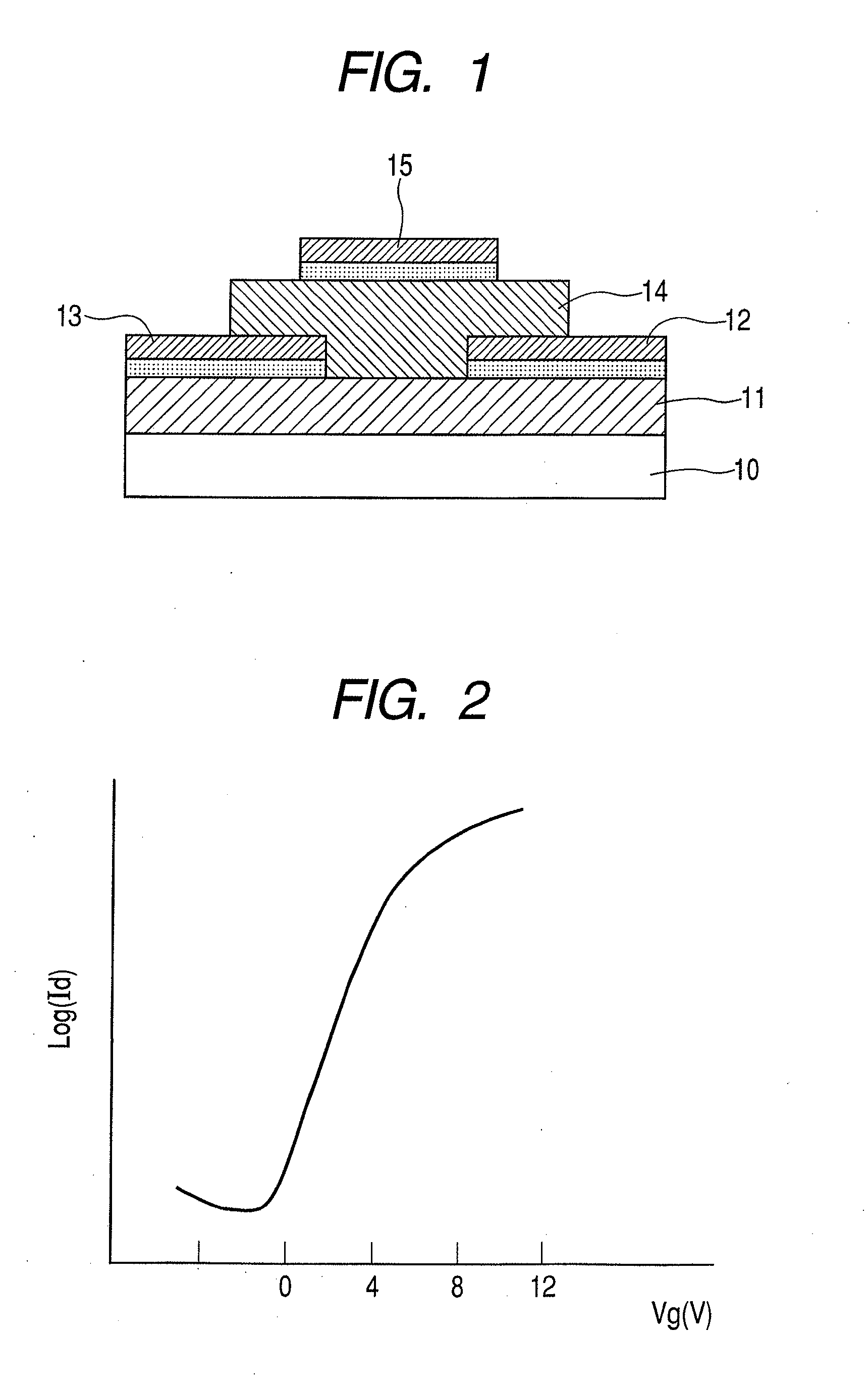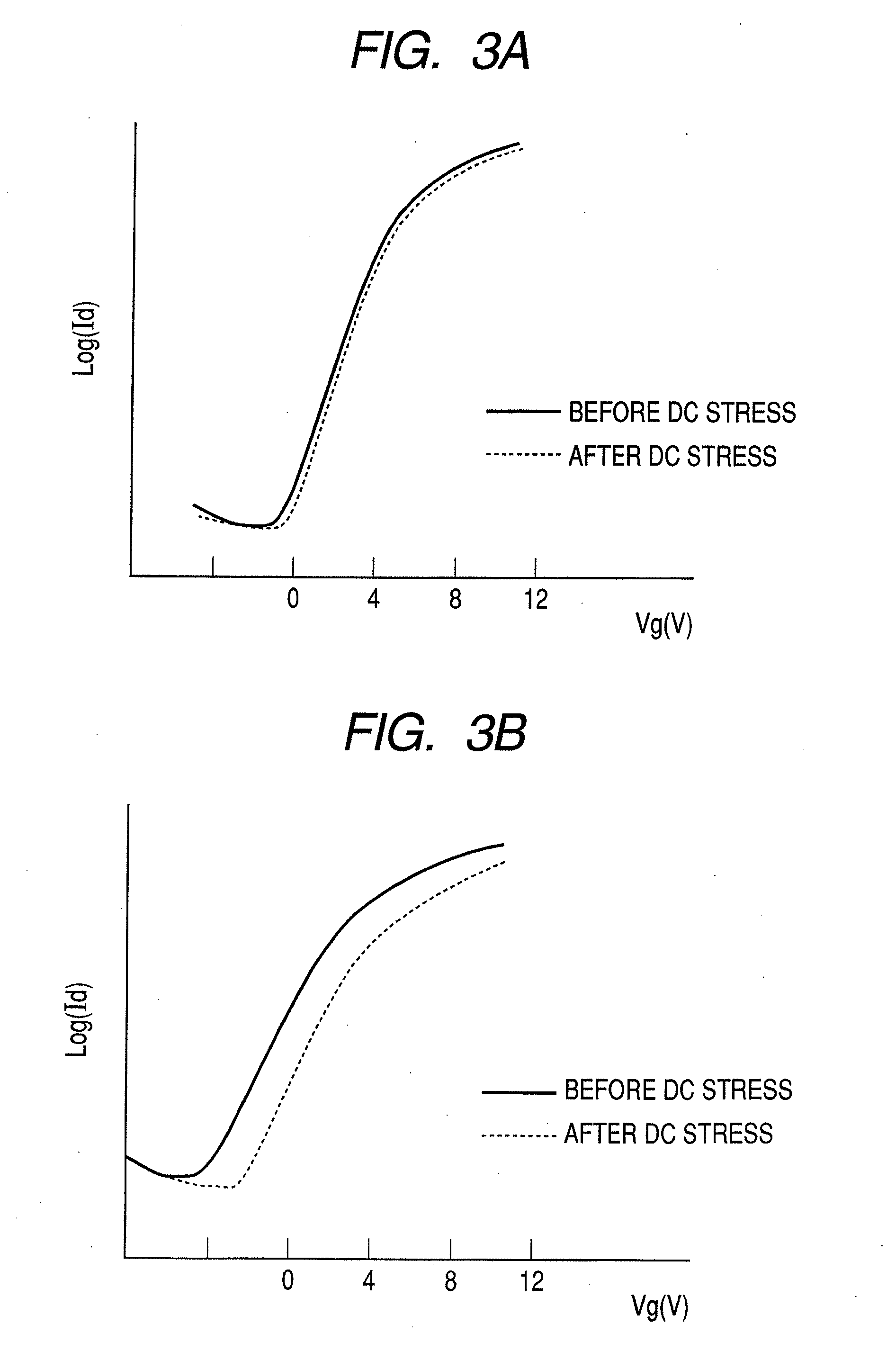Production method of thin film transistor using amorphous oxide semiconductor film
a production method and semiconductor film technology, applied in the direction of semiconductor devices, electrical appliances, basic electric elements, etc., can solve the problems of affecting tft, dc stress affecting tft, and hardly attaining transistor characteristics, etc., to achieve effective control of resistivity, reduce dc stress, and reduce the effect of film quality degradation
- Summary
- Abstract
- Description
- Claims
- Application Information
AI Technical Summary
Benefits of technology
Problems solved by technology
Method used
Image
Examples
example 1
[0082]An embodiment of the TFT device of the present invention is described with reference to FIG. 1.
[0083]First, an In—Ga—Zn—O film was formed on a glass substrate 10 as a channel layer 11.
[0084]In present Example, the In—Ga—Zn—O film was formed by sputtering in an argon atmosphere and by annealing in the air.
[0085]As a target (a material source), a 2-inch sized sintered body having a composition of InGaZnO4 was used, and the applied RF power was 100 W. The distance between the target and the substrate was approximately 9 cm. The In—Ga—Zn—O film was formed in an argon atmosphere of 3.5×10−1 Pa with the introduced oxygen partial pressure of 0 Pa. The substrate temperature at the time of film formation was 25° C.
[0086]Next, the In—Ga—Zn—O film fabricated by a sputtering method was annealed in the ambient air atmosphere set at 300° C. for 1 hour. The obtained film was subjected to a four-probe measurement, and the following results were obtained: the In—Ga—Zn—O film before the anneali...
example 2
[0092]An embodiment of the TFT device in the present invention is described with reference to FIG. 1.
[0093]First, an In—Ga—Zn—O film was formed as a channel layer 11 on a glass substrate 10.
[0094]In present Example, the In—Ga—Zn—O film was formed by a sputtering method in an argon atmosphere and by annealing in an oxygen atmosphere.
[0095]As a target (a material source), a 2-inch sized sintered body having the composition of InGaZnO4 was used, and the applied RF power was 100 W. The distance between the target and the substrate was approximately 9 cm. The In—Ga—Zn—O film was formed in an argon atmosphere of 3.5×10−1 Pa with the introduced oxygen partial pressure of 0 Pa. The substrate temperature at the time of film formation was 25° C.
[0096]Next, the In—Ga—Zn—O film fabricated by a sputtering method was annealed in the oxygen atmosphere set at 280° C. for 30 minutes. The obtained film was subjected to a four-probe measurement, and the following results were obtained: the In—Ga—Zn—O ...
example 3
[0101]An embodiment of the TFT device in the present invention is described with reference to FIG. 1.
[0102]First, an In—Ga—Zn—O film was formed as a channel layer 11 on a glass substrate 10.
[0103]In present Example, the In—Ga—Zn—O film was formed by sputtering in an argon-oxygen mixed gas atmosphere and by annealing in the air.
[0104]As a target, a 2-inch sized sintered body having the composition of InGaZnO4 was used, and the applied RF power was 100 W. The distance between the target and the substrate was approximately 9 cm. The In—Ga—Zn—O film was formed in an argon-oxygen mixed gas atmosphere of 3.5×10−1 Pa with the introduced oxygen partial pressure of 8×10−4 Pa. The substrate temperature at the time of film formation was 25° C.
[0105]Next, the In—Ga—Zn—O film fabricated by a sputtering method was annealed in the ambient air atmosphere set at 250° C. for 20 minutes. The obtained film was subjected to a four-probe measurement, and the following results were obtained: the In—Ga—Zn—...
PUM
 Login to View More
Login to View More Abstract
Description
Claims
Application Information
 Login to View More
Login to View More - R&D
- Intellectual Property
- Life Sciences
- Materials
- Tech Scout
- Unparalleled Data Quality
- Higher Quality Content
- 60% Fewer Hallucinations
Browse by: Latest US Patents, China's latest patents, Technical Efficacy Thesaurus, Application Domain, Technology Topic, Popular Technical Reports.
© 2025 PatSnap. All rights reserved.Legal|Privacy policy|Modern Slavery Act Transparency Statement|Sitemap|About US| Contact US: help@patsnap.com



